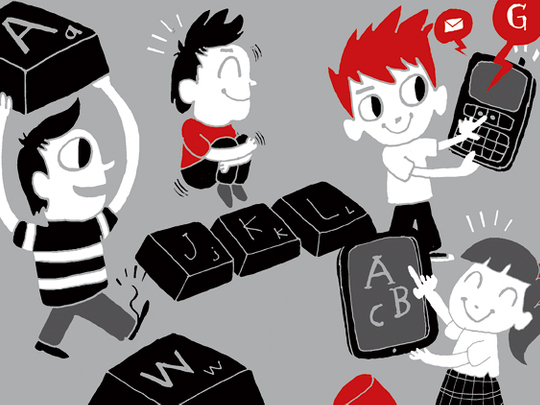
My son, who is 11, has problems tying his shoe laces. He also had problems with his handwriting. Initially I thought he was lazy and might need to practise perfecting his scrawl. But after consulting an occupational therapist I realised what could be the real reason. Like most children his age who are growing up in a computerised world, he's losing the fine motor skills that came from handwriting.
Why are fine motor skills so important? In the preschool years, being able to colour with crayons, cut with scissors, paint with a paintbrush and play with small objects such as Lego, beads and puzzles, are all integral to a child's development. A child has to develop his fine motor skills to be able to do them well. Self-care activities such as tying shoelaces and using a knife and fork to eat food, all require a degree of fine motor control. Children who struggle with any of these activities often feel frustrated and their self-esteem suffers when they can't keep up with their peers.
Writing by hand hones these skills and makes it easier for children to graduate to self-help activities, say experts.
"It's true that a lot of fine motor skills have been lost due to lack of writing," says Dr Onita Nakra, educational psychologist and counsellor, American School of Dubai. "Children now have trouble opening their lunch boxes, buttoning their shirts, and opening bottle tops. Many even have to be taught how to push open doors."
Lack of fine motor skills instilled by activities such as handwriting make children reluctant to attempt even the simplest of motor activities.
Why do pen skills matter?
What is it about holding a pen or pencil and writing with it that opens up so many possibilities in a child? What does this activity do to the brain? According to Dr Karin Harman James, lead researcher and assistant professor in the department of psychological and brain sciences at Indiana University in America, researchers used neuroimaging scans to measure brain activity in "pre-literate pre-school children who were shown letters." One group of children then practised printing letters; the other children practised seeing and saying the letters. After four weeks of training, the kids who practised writing showed brain activation similar to an adult's, says Dr James. The printing practice also improved letter recognition, which is the most important predictor of reading ability at age five.
But at this stage the question is not if handwriting will die out. The question is when.
Will computer keyboard typing be to a child's education what handwriting once was - the building block of learning?
"It should not, and most likely will not," says Dr James. "Handwriting is extremely important for children. It's not about how well they write, but that they should."
The benefits of gripping and moving a pen or pencil across paper go beyond mere communication, says Dr James. She headed an Indiana University research team that studied the benefits of handwriting on children. They discovered that handwriting can change the way children learn and help their brains develop in entirely more productive ways.
"Handwriting increases brain activity, hones fine motor skills and can predict a child's academic success in ways that keyboarding cannot," says James. "Typing just does not have the same effect."
Researchers who tested second, fourth and sixth graders found that children compose essays more prolifically - and faster - when using a pen rather than a keyboard. In addition, fourth and sixth graders wrote more complete sentences when they used a pen, according to the study, led by Virginia Berninger, a University of Washington professor of educational psychology who studies normal writing development and writing disabilities. Her research has also shown that forming letters by hand may engage our thinking brains differently than pressing down on a key. Fourth and sixth graders wrote more complete sentences when they used a pen, she found.
According to Katya Feder, occupational therapist and a professor at the University of Ottawa School of Rehabilitation, if you write a list and then lose it, you're more likely to remember what you wrote than if you had just tried to memorise it in the first place. This, she discovered, was because handwriting engages different brain circuits.
"The contact, direction and pressure of the pen or pencil send a message to the brain. The repetitive process of handwriting integrates motor pathways into the brain," says Feder. "When it becomes automatic or learned, there's almost a groove in the pathways. The more children write, the more pathways are laid down. But if they write them poorly, they will get a faulty pathway which has to be corrected."
‘Feeling' your way through the words
The sense of touch is probably more important to learning than taste or smell, says Feder. When children write in cursive, they "feel" or "experience" the shape of the letters as they form them on paper. Physically forming the letters with the fingers seems to make an ‘imprint' upon the brain. "When children have experienced the process of ‘coding' the words, I think it helps them to ‘decode' the words. Therefore, we might conclude cursive handwriting helps children learn to read."
Coding the words using a tactile activity is more meaningful than using a keyboard because all of the keys on the keyboard feel the same, Feder explains. The difference might be compared to looking at a picture of an object as opposed to seeing a model of the object or the ‘real' thing which a person can touch and feel.
It is widely believed that students who take notes are better learners than students who only depend on their memory. Though not enough research has been done in this field, experts think the actual process of writing might have a substantial influence on memory because to take notes a student must pay close attention to the lecture.
One reason why children are reluctant to write is because teachers focus more on the mechanics of writing, rather than the process. "Writing itself is a very complex activity," says Dr Nakra. "There are developmental phases and stages for writing. With young children, teachers tend to focus more on the output, the product rather than the process." This, Dr Nakra feels, is self-defeating. The focus should instead be on perfecting the process. "I feel that for any kind of long-term gains, process is much more important if you want the child to develop into a prolific writer."
Practice makes perfect
Apart from the scientific reasons that make a compelling case for taking the issue of handwriting seriously, there are a few astonishingly simple factors about handwriting that usually escape our attention.
One of the most important drivers of handwriting is that it needs to be taught in a quiet place, says Nick Ramsay, a teacher and the founder of the ESL Writing Wizard. It needs a dedicated environment such as a proper classroom or an area in the house where it can be practised diligently, free of distractions.
Expecting children to do their homework, and use handwriting as a means of doing so, in noisy surroundings or hectic environments is not right, says Ramsay. "Second, children need to practise what they have learned."
Handwriting applications that allow users to hand-scribble notes on the touch screen rather than paper may prove to be useful tools. Children who would be reluctant to write with a pencil on paper would be thrilled to use their fingers or the stylus on an iPad. The iTunes store has dozens of downloadable apps that can teach them to write on the touch pad. Research is also being conducted on software to help improve handwriting.
What is really important is teachers need a lot more education, feels Dr Nakra. "I feel one of the reasons students hate to write nowadays is because the only feedback that they get is on the most superficial elements of the writing process, handwriting," she says.
"I feel if children are allowed to create a voice of their own when they write and the focus shifts to how you evaluate yourself as a writer - what you are trying to communicate - I think the attitude of the students will change dramatically."
She speaks from experience. "In our school we have a fantastic reading and writing workshop where we emphasise the fact that writing is a form of communication. Children are taught from a very young age that they are writers and authors, and that they are creating a work of art."
In Dr Nakra's opinion, writing is not just a movement of the pen on paper using motor skills. It is also a way of firing the imagination, mastering the means of expression through words and a whole new way of exploring one's abilities. The teachers' role, says Dr Nakra, is enormously important because she guides a child through so many creative processes in writing such as editing, proof reading, developing and shaping content as well.
Children today are reluctant to write because their learning is a case of too much too soon. "One complaint is that some education systems push writing at too early an age, " says Dr Nakra. "Teachers need to understand the developmental phases of writing. Writing is an extremely complex activity. You have to think, mull over the details, organise the thoughts in your head and write them down in the proper sequence. In some cases I've heard of three-year-olds forced to hold a pen and copy sentences after sentences from the board, which is not developmentally appropriate because their fingers as well as brains are not yet ready for the labour. It is physically an extremely laborious task."
Her advice is to get the kids first to start scribbling, then drawing and evolve naturally to writing when they are really ready for it - well past the age of five. "Teachers really need to be sensitive to these aspects," she says. "They need to focus a lot more on the content and ideas, the motives. They don't pay attention to why they should make a child write, what's the motivation, how to encourage them."
If the teachers do not prevail, children of the coming generations may grow up using only a crude form of writing for the rare occasions in life when they need to communicate by pen.
While email, instant messaging, texting are all very important means of communication, they are also impersonal in a way that they are out of context of the human contact. Why else do we still treasure that hand-written note we received so many years ago? And though cursive may be tedious and as adults we may choose not to use it, it will help our children's brains develop. The best part is it can be fun.
Lessons for teachers
The website Handwriting Without Tears (www.hwtears.com) suggests strategies that
can help with diverse learning styles
Lessons and activities
The Handwriting Without Tears curriculum recommends teaching the easiest skills first, and then building on prior knowledge. Letters are taught in a sequence that makes
sense developmentally: in groups of similar formation. After children master the easier letters, they are ready for more difficult letters in both print and cursive.
Multisensory lessons
The website suggests helping children develop their writing skills through multisensory play-based instruction. Activities with hands-on materials – a set of wood pieces, capital letter cards, mat, CDs, slate chalkboard, and blackboard – address different senses to teach correct formation, spacing, sequencing, and other writing skills. Children move, touch, feel, and manipulate real objects as they learn the habits and skills essential for writing.
Review and mastery
Mastery of concepts should be reinforced with three levels of review and mastery activities throughout student workbooks. The sections follow a group of letters and focus on reinforcing the formation of all previously taught letters.
Learn and check
Workbooks should be used to teach children to check their letter, word, and sentence skills after new lessons. Letters should be checked for correct start, steps, and whether they are touching the lines. Words must be checked for correct size, placement, and closeness. Sentences must be checked for correct capitalisation, word spacing, and punctuation.
Inside info
For more information on research by Dr Karin Harman James, go to www.iub.edu/~canlab/Research.html
For Nick Ramsay's worksheets go to www.writingwizard.longcountdown.com












